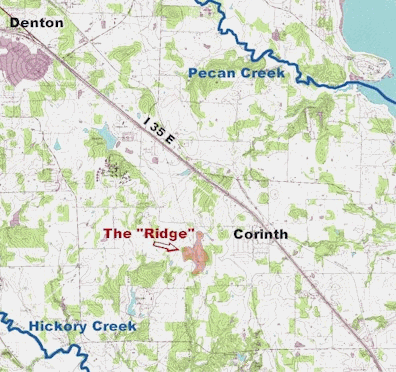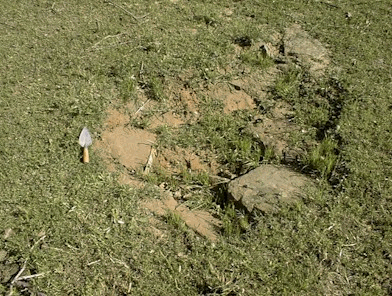-First Alton Site-
Prepared by
Barry Vermillion
Chair, Archaeology Committee, DCHC
Texas Archaeological Steward
-The First Alton-
June 1, 1848 – January 31, 1851
(2 years, 7 months, and 30 days).
On February 4, 1848, the state legislature designated the county seat be moved, effective June 1, 1848, from Pinckneyville, Texas, to Section 1, Township No. 4, north, in Range No. 3, west, in Peters Colony. Commissioners were appointed and directed to purchase or receive by donation no less than forty acres at the new location to be known as Alton, Texas. Commissioners were directed to lay out a town and sell lots by public auction. The funds received were to be used to erect county buildings. If records concerning a survey, public auction, or funds received by any public auction at Alton ever existed they have not been found.
Ed Bates describes the location of Alton as "…being on the high ridge between Pecan Creek and Hickory Creek." The highest ridge between Pecan and Hickory Creeks within the area described by Bates appears to be the ridge that extends along Post Oak Drive. The ridge is indicated on the U.S. Geological Survey, Denton East, 7.5 min., topographic map. (See Figure 1.)

Figure 1. The "ridge" is shaded in red.
Bates also states that "…the county seat was near the Thedford place near the present station of Corinth." Near the middle, eastern portion of this ridge is property that was once owned by a Thetford. On the west side of the former Thetford property is the current Fletcher Farm. On the West Side of Fletcher Farm is Post Oak Drive. Bates added, "A well was dug and no water found." There is a hand dug well on Fletcher Farm that was reported to be dry when it was filled in a few years ago to eliminate danger to livestock. (See Figure 2.)

Figure 2. Well on Fletcher Farm before clearing and cleaning of surface. Trowel points north.
There have been no records found that indicate any public buildings were erected at First Alton. C.A. Bridges writes, "Seemingly the residence of W.C. Baines was the only one near this seat of justice." Some county records indicate the location of the former Baines property as once being the property now known as Fletcher Farm and the James Property which is located on the west side of Post Oak Drive. Bridges added, "Court was held in the Baines’ residence, on the porch, or outdoors in the yard…Apparently, most of the meetings were held under the shade of convenient trees." It should be noted that Post Oak Drive was named for the many old oak trees that once grew on both sides of the road. A few remaining oaks in the area may be old enough to have witnessed the coming of the first Anglo settlers to the area before it was called Alton. One large oak a few meters northwest of a hand dug well on the James Property measures 2.59 meters, or 102 inches in girth. The estimated diameter of the oak is approximately 32.48 inches. If an average growth ring representing one year of growth is one sixteenth of an inch, the oak is approximately 259.84 years old. However, with equal numbers of growth rings of one eighth and one sixteenth of an inch, the approximate age is 194.88 years. First Alton was designated as county seat 152 years ago. Based on this estimate, the oak could have been no less than 44 years and no more than 110 years old at the time of the designation of county seat.
Apparently, W.C. Baines had established a farmstead long before the designation of the new county seat of First Alton. It is reasonable to assume that Mr. Baines had found a reliable source of water for his selected farmstead. It is also reasonable to assume that the county held court in or at his home because of the availability of water until a county well could be dug. The James property hand dug well still retains water. Oral history indicates this well served as the water source for a farmstead in the early days of Denton County, probably that of W.C. Baines, that included a house and outbuildings. No other hand-dug wells have been found, or reported, on "the ridge", other than the two recorded here.
Writing about Old Alton (the second Alton), and referring to Pinckneyville and First Alton, Bates adds, "At the two preceding county seats no public buildings had been erected." It is assumed that the county commissioners determined it would be better to move to a location where water was available instead of digging another well at First Alton. To complicate matters, ownership of most property assigned by the Peter’s Colony was in doubt, including Alton. It is reasonable to assume the well on the James Property is the well of the former W.C. Baines farmstead. The well on Fletcher Farm was most likely the dry county well.
-References-
Bates, E.F. History and Reminiscences of Denton County. Denton: Terrill Wheeler Printing, 1989.
Bridges, C.A. History of Denton, Texas From Its Beginning to 1960. Waco: Texian Press, 1978.
Denton County records and archives, Denton County Courthouse.
![]()
![]()
Notes:
The Altons: The Second and Third
County Seats
Of
Denton County, Texas
The first county seat was created by the First Legislature of the State of Texas on April 11, 1846, and it was named Pinckneyville. The location of Pinckneyville was considered unacceptable by the citizens of the county. On February 4, 1848, the location was moved more to the southeast of the center of the county and a new name, Alton, was designated for the second county seat. This site has been referred to as New Alton causing some confusion for contemporary researchers, because on November 26, 1850, the location of the county seat was moved again to the south-southwest and also designated as Alton. It is this last site that is referred to today as Old Alton, yet it is the second town site with the name Alton and not the oldest designated site of the two Altons. The following is given for clarification:
County Seats of Denton County, Texas
First: Pinckneyville, April 11, 1846
Second: Alton, or First Alton, February 4, 1848
Third: Old Alton, November 26, 1850
Fourth: Denton, November, the first Tuesday, 1856
In Committee research documents we will refer to the first site of Alton as First Alton and the second site of Alton as Old Alton. This is the opposite of what the names should be, but these are the names used by citizens today.